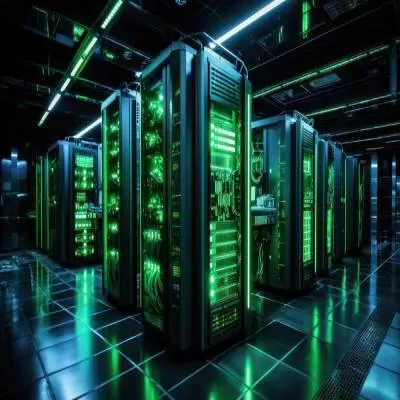- Home
- Technology
- Data Centre Dynamics

Data Centre Dynamics
In line with global trends, the Indian data centre (DC) market is growing rapidly, propelled by the growth of e-commerce, telecommunications, Internet usage and the demand for cloud computing. DC space in India, which was about 3.4 million sq ft in 2009 and grew to about 5.2 million sq ft in 2012, is expected to reach 6.3 million sq ft by 2017. The industry growth rate is around 25 per cent per annum. Currently, there are 105 colocation DCs in India; Bengaluru leads the list with 20 DCs followed by Mumbai with 18 and New Delhi with 12. As part of India´s National eGovernance Plan, State Data Centres (SDC) have also been established; approved in January 2008, many SDCs are already operational.
While client-owned and operated captive DCs are still dominant in India, hosted or third-party DCs are also on the rise. The increased focus on DC efficiency, reliability and cost optimisation has led many midmarket and government-owned enterprises to increasingly opt for third-party DCs, primarily to enable them focus on their core business.
While client-owned and operated captive DCs are still dominant ´The third-party DC market is growing exponentially both internationally and in India,´ reports Piyush Gandhi, National Director, Project & Development Services, JLL. ´As per a recent report from 451 Research, the DC colocation market annualised revenue is projected to reach $36 billion worldwide by end of 2017, from the present $25 billion. If we analyse the industry, around 75 per cent of this revenue comes from local providers and hence constant consolidation is happening in this sector. It is estimated that an additional 40 million sq ft will be added globally in this market by the end of 2017. Interestingly, a significant part of this will be in the Asia-Pacific region, which currently contributes to around 25 per cent of the global market. In India, this market is expected to grow at 25-30 per cent. Almost all players in the Indian market have expansion plans and significant growth is expected in this industry till 2020. JLL manages around 600,000 sq ft of DC facilities across the country for leading global and Indian corporations, including banks.
Some key players among third-party service providers are Tata Communications, Netmagic, Reliance, Bharti Airtel, Tulip, CtrlS, Sify Technologies, Spectranet, and Infosys. Others with varying presence across segments like hardware equipment, software solutions, power and security include IBM, HP, Wipro, HCL, TCL, Cisco, Emerson and Schneider. The users of such services are largely telecom services and carriers (55 per cent), service management outsourcing (30 per cent) and corporate banking and global business (15 per cent).
The growing complexity of DC operations, including network infrastructure and energy usage, is expected to push more enterprises to opt for third-party facilities, which no doubt have several advantages. ´They have inherent benefits like predictable expenditure model, scalable capacity with quick turnaround time, economy, management by experienced professionals, dedicated infrastructure to build cloud strategy, and better disaster recovery management,´ points out Gandhi.
The trends
At present, rapidly increasing data traffic is driving the demand for data storage, resulting in continuous expansion of the global DC market.
To accommodate this enormous amount of data, companies are forced to operate a number of DCs in different locations, resulting in high capital and operational costs. Hence, a major emerging global trend is a move towards consolidation, where organisations are setting up massively scalable and cost-effective DCs, so the additional cost of adding thousands of users would be negligible.
With mounting concern over the energy DCs consume, development of green DCs is another trend gaining momentum internationally and in India to reduce power consumption and environmental impact. Using alternative sources of energy like wind and solar, green-rated power equipment and incorporating wireless heat sensors are some of the measures undertaken by green DCs.
Another shift is towards modular DCs, where modular products and solutions for IT, power, cooling and prefabricated building components are used. While reducing the upfront cost of designing and constructing a DC, this also ensures faster deployment and increased flexibility. This trend has caught up in India too, according to PV Rao, Managing Director, Pennar Engineered Building Systems Ltd. ´Earlier in India, DCs were being built in RCC and by conventional methods,´ he says. ´However, after explosive growth in the construction industry in the past decade, there has been a national crisis of shortage of skilled manpower. As a result, most companies are now opting for pre-engineered solutions, for obvious reasons like speed and ease of construction, economy, aesthetical appearance and ease of maintenance.´ However, he cautions that as DCs usually house heavy equipment, appropriate provision for equipment loads should be made while designing the building. Pennar is currently developing a multi-storied DC with pre-engineered building components at Chennai for Reliance Jio.
Software-defined DCs are also gaining traction, points out Mahesh Trivedi, Senior Vice President and Head-DC Facilities, Netmagic. ´DCs are becoming more software-driven, with infrastructure management systems increasingly integrating with IT management systems,´ he says. ´This will make DCIM software more effective and useful, including in hybrid DC environments, which will also force companies and suppliers to innovate more and focus on integration.´ Netmagic, which has set up nine data centres across India, has two projects in the pipeline: one in Bengaluru and one in Mumbai.
The opportunities
The emerging DC market has no doubt opened up a world of opportunities for all stakeholders: From software service providers and hardware equipment suppliers to architects, builders and vendors. ´To understand this opportunity in detail, it is important to dive deep into the basics of DC setup,´
explains Gandhi. ´The level of backups and provisions required for Tier-III (99.982 per cent), which allows 1.5768 hours downtime in a year, or Tier-IV (99.995 per cent), which allows 0.438 hours downtime in a year, is extreme and thus will create demand for technology, products, infrastructure and people. DCs are also high power consumption zones, with dense arrays of computer and telecommunication systems and equally dense cabling. For this reason, DCs require well-planned sturdy buildings, multiple fibre lines for Internet and a large number of equipment associated with power supply, cooling systems, fire extinguishing and building management systems. This provides a focused opportunity to developers for buildings and infrastructure, design consultants, project or facility management companies, contractors and consultants. In addition, HVAC, building management system suppliers, IT equipment suppliers, cable suppliers and consultants and power companies can also share the growth prospects.´
Development and costs
The construction of DCs, which involves several facets, requires specialised expertise as well as meticulous project planning, design coordination and management of multiple suppliers and contractors. ´The requirements for DC buildings including mechanical and electrical provisions are of much higher specifications compared to regular buildings,´ affirms Gandhi. ´For instance, they may need slab loading capacity of 1,500 kg per sq m while in most commercial buildings, it would be around 500 kg per sq m. Further, floor-to-floor height requirements are also higher. However, such premises are limited and if the building has to be developed from scratch, overall project timelines increase.´
JLL recently partnered with Netmagic to develop its Mumbai DC at Chandivali, which was completed in a record time of 15 months.
The construction of DCs is also highly dependent on present and future business requirements, according to RK Rathi, Deputy General Manager (Projects), Engineers India Ltd (EIL). ´Planning of infrastructure considering the requirement of future expansion is essential so that when taken up, it causes least interference with running systems and least downtime or shutdown of the DC. Other factors taken into account while designing and developing DCs include redundancy of the system required as per the operational criticality of the client, availability of power from grid or sufficient backup from alternate sources, security and surveillance aspects, quality and coordination of all the services during design and execution.´ EIL has set up several DCs for various refinery, gas and petrochemical projects, as well as the Directorate General of Hydrocarbon (DGH) DC in New Delhi. The SBI DC in Hyderabad is in the pipeline. Significant projects for EIL include UIDAI (Unique Identification Authority of India) DCs in Manesar and Bengaluru, which are blast-proof constructions of RCC shell and earthquake-resistant for one higher zone. Built at Rs 405 crore, these Tier-III DCs with integrated biometric access control and surveillance system are also LEED Gold-rated complexes.
The cost of building DCs varies depending on the type, space required, power, cooling and network access. ´The construction cost for just a DC fit-out would be in the range of around Rs 10,000-18,000 per sq ft of carpet area, with the major proportion going to DG sets, HVAC systems, high side and low side electrical system and UPS,´ informs Gandhi. ´The cost for base building, IT equipment and telecommunication systems will be additional.´
The challenges
The challenges before DC developers and managers are manifold: Lack of uninterrupted power supply, security of the data and the DC, balancing costs with proximity demands, space crunch and rising real-estate costs, countering competition from within the country and outside, disaster recovery.
´The challenges are on multiple fronts,´ agrees Gandhi. ´Being an extremely power-intensive project, getting adequate and high-quality power supply poses a big challenge. The standby requirements for diesel generators need sizable fuel tanks and necessary approvals. The approval process sometimes takes longer increasing project timelines. Keeping pace with the fast evolving industry and technology and consequent facility upgrade is another major challenge.´
In fact, some of these issues have resulted in India losing out on business to other countries, says Trivedi. ´Infrastructure bottlenecks, the precarious power situation and outdated telecom policies have resulted in the country losing business to other countries like Singapore, Hong Kong and Taiwan.
There are other impediments too, like enforceability of contracts, law and order and high cost of Internet bandwidth, considered the lifeline of the data centre industry. Another big issue is that of charges related to cable-landing stations, which are the points at which submarine cables (optical fibre cables that carry Internet traffic) enter and exit the mainland. Station owners often impose hefty fees for allowing Internet service traffic to pass through. Diesel-based generator sets are a must because of power outages. To store diesel for 48 hours, a different licence is required, which adds to the headache of companies.´
The future
Despite the obstacles, going forward the Indian DC market is expected to witness significant growth with increased adoption of third-party DC services. ´According to research firm Gartner, the Indian DC infrastructure market is expected to reach $2 billion in 2016, a 5.2 per cent increase over last year,´ shares Trivedi. ´Within the Indian IT infrastructure market, server revenue is forecast to reach $698 million in 2016, an increase of 5.3 per cent over 2015. Enterprise networking will continue to be the biggest segment with revenue expected to touch $963 million in 2016. With increased focus on mobility and big data activities in India, software-defined networking has the highest adoption rate among Indian enterprises. Storage modernisation and consolidation, backup and recovery and disaster recovery are some key drivers and are likely to remain relevant through 2019.´ Evidently, India is emerging as a high-growth area for DC hosting.
Quick Bytes
- Data centre space in India expected to reach 6.3 million sq ft by 2017.
- Market growth drivers: e-commerce, telecommunications, Internet usage and demand for cloud computing.
- Client-owned and operated captive DCs are dominant in India; hosted or third-party DCs are on the rise.
- Construction cost for just a DC fit-out: Around `10,000-18,000 per sq ft of carpet area.
Data on data centres
- The global DC construction market to grow from
- $14.59 billion in 2014 to $22.73 billion by 2019, at a CAGR of 9.3 per cent.
- Globally, there are around 3,790 colocation DCs spread over 113 countries with the US having around 45 per cent of them.
- Indian DC space, which was 3.7 million sq ft in 2012, is expected to reach 6.3 million sq ft by 2017.
- The Indian DC industry growth rate is around 25 per cent per annum.
- Currently, there are 105 colocation DCs in India.
- Over 16 state governments in India have fully functional DCs.
- DCs can be over 40 times as energy-intensive as conventional office buildings.
- The biggest DC in the world is the Lakeside Technology Centre in Chicago (1.1 million sq ft) and the next biggest is the QTS Metro DC in Atlanta (9.7 lakh sq ft).
Source: Industry sources
- Janaki Krishnamoorthi
To share your views on the Indian data centre market, write in at feedback@ASAPPmedia.com
- Indian data centre market
- India´s National eGovernance Plan
- State Data Centres
- Piyush Gandhi
- JLL
- Tata Communications
- Netmagic
- Reliance
- Bharti Airtel
- Tulip
- CtrlS
- Sify Technologies
- Spectranet
- Infosys
- IBM
- HP
- Wipro
- HCL
- TCL
- Cisco
- Emerson
- Schneider
- PV Rao
- Pennar Engineered Building Systems Ltd
- pre-engineered building
- Mahesh Trivedi
- Netmagic
- RK Rathi
- EIL
- UIDAI
- LEED
- Indian
The Indian data centre market, with a growth rate of 25 per cent per annum, is certainly emerging as a hotspot for data centre hosting. In line with global trends, the Indian data centre (DC) market is growing rapidly, propelled by the growth of e-commerce, telecommunications, Internet usage and the demand for cloud computing. DC space in India, which was about 3.4 million sq ft in 2009 and grew to about 5.2 million sq ft in 2012, is expected to reach 6.3 million sq ft by 2017. The industry growth rate is around 25 per cent per annum. Currently, there are 105 colocation DCs in India; Bengaluru leads the list with 20 DCs followed by Mumbai with 18 and New Delhi with 12. As part of India´s National eGovernance Plan, State Data Centres (SDC) have also been established; approved in January 2008, many SDCs are already operational. While client-owned and operated captive DCs are still dominant in India, hosted or third-party DCs are also on the rise. The increased focus on DC efficiency, reliability and cost optimisation has led many midmarket and government-owned enterprises to increasingly opt for third-party DCs, primarily to enable them focus on their core business. While client-owned and operated captive DCs are still dominant ´The third-party DC market is growing exponentially both internationally and in India,´ reports Piyush Gandhi, National Director, Project & Development Services, JLL. ´As per a recent report from 451 Research, the DC colocation market annualised revenue is projected to reach $36 billion worldwide by end of 2017, from the present $25 billion. If we analyse the industry, around 75 per cent of this revenue comes from local providers and hence constant consolidation is happening in this sector. It is estimated that an additional 40 million sq ft will be added globally in this market by the end of 2017. Interestingly, a significant part of this will be in the Asia-Pacific region, which currently contributes to around 25 per cent of the global market. In India, this market is expected to grow at 25-30 per cent. Almost all players in the Indian market have expansion plans and significant growth is expected in this industry till 2020. JLL manages around 600,000 sq ft of DC facilities across the country for leading global and Indian corporations, including banks. Some key players among third-party service providers are Tata Communications, Netmagic, Reliance, Bharti Airtel, Tulip, CtrlS, Sify Technologies, Spectranet, and Infosys. Others with varying presence across segments like hardware equipment, software solutions, power and security include IBM, HP, Wipro, HCL, TCL, Cisco, Emerson and Schneider. The users of such services are largely telecom services and carriers (55 per cent), service management outsourcing (30 per cent) and corporate banking and global business (15 per cent). The growing complexity of DC operations, including network infrastructure and energy usage, is expected to push more enterprises to opt for third-party facilities, which no doubt have several advantages. ´They have inherent benefits like predictable expenditure model, scalable capacity with quick turnaround time, economy, management by experienced professionals, dedicated infrastructure to build cloud strategy, and better disaster recovery management,´ points out Gandhi. The trends At present, rapidly increasing data traffic is driving the demand for data storage, resulting in continuous expansion of the global DC market. To accommodate this enormous amount of data, companies are forced to operate a number of DCs in different locations, resulting in high capital and operational costs. Hence, a major emerging global trend is a move towards consolidation, where organisations are setting up massively scalable and cost-effective DCs, so the additional cost of adding thousands of users would be negligible. With mounting concern over the energy DCs consume, development of green DCs is another trend gaining momentum internationally and in India to reduce power consumption and environmental impact. Using alternative sources of energy like wind and solar, green-rated power equipment and incorporating wireless heat sensors are some of the measures undertaken by green DCs. Another shift is towards modular DCs, where modular products and solutions for IT, power, cooling and prefabricated building components are used. While reducing the upfront cost of designing and constructing a DC, this also ensures faster deployment and increased flexibility. This trend has caught up in India too, according to PV Rao, Managing Director, Pennar Engineered Building Systems Ltd. ´Earlier in India, DCs were being built in RCC and by conventional methods,´ he says. ´However, after explosive growth in the construction industry in the past decade, there has been a national crisis of shortage of skilled manpower. As a result, most companies are now opting for pre-engineered solutions, for obvious reasons like speed and ease of construction, economy, aesthetical appearance and ease of maintenance.´ However, he cautions that as DCs usually house heavy equipment, appropriate provision for equipment loads should be made while designing the building. Pennar is currently developing a multi-storied DC with pre-engineered building components at Chennai for Reliance Jio. Software-defined DCs are also gaining traction, points out Mahesh Trivedi, Senior Vice President and Head-DC Facilities, Netmagic. ´DCs are becoming more software-driven, with infrastructure management systems increasingly integrating with IT management systems,´ he says. ´This will make DCIM software more effective and useful, including in hybrid DC environments, which will also force companies and suppliers to innovate more and focus on integration.´ Netmagic, which has set up nine data centres across India, has two projects in the pipeline: one in Bengaluru and one in Mumbai. The opportunities The emerging DC market has no doubt opened up a world of opportunities for all stakeholders: From software service providers and hardware equipment suppliers to architects, builders and vendors. ´To understand this opportunity in detail, it is important to dive deep into the basics of DC setup,´ explains Gandhi. ´The level of backups and provisions required for Tier-III (99.982 per cent), which allows 1.5768 hours downtime in a year, or Tier-IV (99.995 per cent), which allows 0.438 hours downtime in a year, is extreme and thus will create demand for technology, products, infrastructure and people. DCs are also high power consumption zones, with dense arrays of computer and telecommunication systems and equally dense cabling. For this reason, DCs require well-planned sturdy buildings, multiple fibre lines for Internet and a large number of equipment associated with power supply, cooling systems, fire extinguishing and building management systems. This provides a focused opportunity to developers for buildings and infrastructure, design consultants, project or facility management companies, contractors and consultants. In addition, HVAC, building management system suppliers, IT equipment suppliers, cable suppliers and consultants and power companies can also share the growth prospects.´ Development and costs The construction of DCs, which involves several facets, requires specialised expertise as well as meticulous project planning, design coordination and management of multiple suppliers and contractors. ´The requirements for DC buildings including mechanical and electrical provisions are of much higher specifications compared to regular buildings,´ affirms Gandhi. ´For instance, they may need slab loading capacity of 1,500 kg per sq m while in most commercial buildings, it would be around 500 kg per sq m. Further, floor-to-floor height requirements are also higher. However, such premises are limited and if the building has to be developed from scratch, overall project timelines increase.´ JLL recently partnered with Netmagic to develop its Mumbai DC at Chandivali, which was completed in a record time of 15 months. The construction of DCs is also highly dependent on present and future business requirements, according to RK Rathi, Deputy General Manager (Projects), Engineers India Ltd (EIL). ´Planning of infrastructure considering the requirement of future expansion is essential so that when taken up, it causes least interference with running systems and least downtime or shutdown of the DC. Other factors taken into account while designing and developing DCs include redundancy of the system required as per the operational criticality of the client, availability of power from grid or sufficient backup from alternate sources, security and surveillance aspects, quality and coordination of all the services during design and execution.´ EIL has set up several DCs for various refinery, gas and petrochemical projects, as well as the Directorate General of Hydrocarbon (DGH) DC in New Delhi. The SBI DC in Hyderabad is in the pipeline. Significant projects for EIL include UIDAI (Unique Identification Authority of India) DCs in Manesar and Bengaluru, which are blast-proof constructions of RCC shell and earthquake-resistant for one higher zone. Built at Rs 405 crore, these Tier-III DCs with integrated biometric access control and surveillance system are also LEED Gold-rated complexes. The cost of building DCs varies depending on the type, space required, power, cooling and network access. ´The construction cost for just a DC fit-out would be in the range of around Rs 10,000-18,000 per sq ft of carpet area, with the major proportion going to DG sets, HVAC systems, high side and low side electrical system and UPS,´ informs Gandhi. ´The cost for base building, IT equipment and telecommunication systems will be additional.´ The challenges The challenges before DC developers and managers are manifold: Lack of uninterrupted power supply, security of the data and the DC, balancing costs with proximity demands, space crunch and rising real-estate costs, countering competition from within the country and outside, disaster recovery. ´The challenges are on multiple fronts,´ agrees Gandhi. ´Being an extremely power-intensive project, getting adequate and high-quality power supply poses a big challenge. The standby requirements for diesel generators need sizable fuel tanks and necessary approvals. The approval process sometimes takes longer increasing project timelines. Keeping pace with the fast evolving industry and technology and consequent facility upgrade is another major challenge.´ In fact, some of these issues have resulted in India losing out on business to other countries, says Trivedi. ´Infrastructure bottlenecks, the precarious power situation and outdated telecom policies have resulted in the country losing business to other countries like Singapore, Hong Kong and Taiwan. There are other impediments too, like enforceability of contracts, law and order and high cost of Internet bandwidth, considered the lifeline of the data centre industry. Another big issue is that of charges related to cable-landing stations, which are the points at which submarine cables (optical fibre cables that carry Internet traffic) enter and exit the mainland. Station owners often impose hefty fees for allowing Internet service traffic to pass through. Diesel-based generator sets are a must because of power outages. To store diesel for 48 hours, a different licence is required, which adds to the headache of companies.´ The future Despite the obstacles, going forward the Indian DC market is expected to witness significant growth with increased adoption of third-party DC services. ´According to research firm Gartner, the Indian DC infrastructure market is expected to reach $2 billion in 2016, a 5.2 per cent increase over last year,´ shares Trivedi. ´Within the Indian IT infrastructure market, server revenue is forecast to reach $698 million in 2016, an increase of 5.3 per cent over 2015. Enterprise networking will continue to be the biggest segment with revenue expected to touch $963 million in 2016. With increased focus on mobility and big data activities in India, software-defined networking has the highest adoption rate among Indian enterprises. Storage modernisation and consolidation, backup and recovery and disaster recovery are some key drivers and are likely to remain relevant through 2019.´ Evidently, India is emerging as a high-growth area for DC hosting. Quick Bytes Data centre space in India expected to reach 6.3 million sq ft by 2017. Market growth drivers: e-commerce, telecommunications, Internet usage and demand for cloud computing. Client-owned and operated captive DCs are dominant in India; hosted or third-party DCs are on the rise. Construction cost for just a DC fit-out: Around `10,000-18,000 per sq ft of carpet area. Data on data centres The global DC construction market to grow from $14.59 billion in 2014 to $22.73 billion by 2019, at a CAGR of 9.3 per cent. Globally, there are around 3,790 colocation DCs spread over 113 countries with the US having around 45 per cent of them. Indian DC space, which was 3.7 million sq ft in 2012, is expected to reach 6.3 million sq ft by 2017. The Indian DC industry growth rate is around 25 per cent per annum. Currently, there are 105 colocation DCs in India. Over 16 state governments in India have fully functional DCs. DCs can be over 40 times as energy-intensive as conventional office buildings. The biggest DC in the world is the Lakeside Technology Centre in Chicago (1.1 million sq ft) and the next biggest is the QTS Metro DC in Atlanta (9.7 lakh sq ft). Source: Industry sources - Janaki Krishnamoorthi To share your views on the Indian data centre market, write in at feedback@ASAPPmedia.com




















